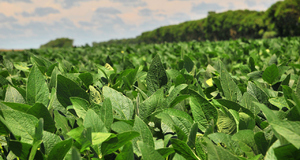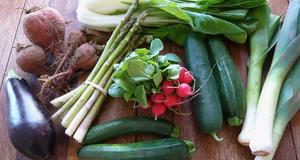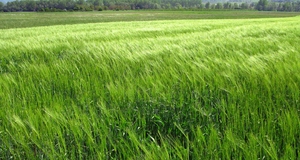From Center for Development and Strategy VOL. 2016 NO. 1Effects of Conventional and Organic Agricultural Techniques on Soil EcologyYields, Resources, and SustainabilityThe importance of yields cannot be overstated. At the same time, the world is finite and increasing yields through the continued reliance on external chemical fertilizer, pesticide, and water inputs poses growing challenges and issues from a sustainability perspective. Soil is not necessarily an easily renewable resource as it takes a very long time for soil to accumulate (Murck et al, 2013). Most of the inputs that are required for conventional farming are derived from non sustainable sources. Pesticides are derived from fossil fuels and chemical sources, while the concept of peak phosphorus and peak potassium, which is similar to peak oil, poses the question of when the finite resources of phosphorus will be depleted. These issues need to be considered when evaluating the sustainability of agricultural yields in the long run. Yields from conventional/monoculture agriculture are generally higher than organic agriculture. A quantitative synthesis of studies conducted by Badgley et al (2007) show that yields in organic agriculture were around 8.7% lower than conventional agriculture with a 95% confidence interval based on 138 comparisons. Meanwhile, Kremin & Miles (2012) conclude there is still uncertainty about the comparison between differing yields from organic and conventional agriculture because of a general lack of available studies. This is still an area where more research is needed. Regardless, the large scale tendencies of conventional farming operations result in lowering direct costs of production through achieving economies of scale. However, like other industries, conventional farming has brought about significant costs that have been externalized to society and natural ecosystems. It can take 500 to 10,000 years for one centimetre of topsoil to accumulate depending on climate, biome, and rate of mineral accumulation (Murck, 2013). Soil then, is technically a renewable resource, but not in human lifetimes. To manage any renewable resource, the exploitation cannot exceed regeneration. The Food and Agriculture Organization of the United Nations has estimated that 24 billion tons of fertile soil are lost each year across the world. This represents $490 billion in lost ecological services in one year. As soil is lost, humanity's capacity to grow food decreases. This is a sobering fact when considering the future demands for food as the world's population grows. Tilman et al. (2002) expect food demand to double by 2050 based on the increasing consumption of calorie and meat intensive diets. Society and future generations will bear the cost of lost soil resources. But when farmers are working with small profit margins, yields are one of the major factors in determining operational strategy. As such, farmers will be hesitant to adjust their strategies from conventional agriculture to organic agriculture. However, by using net present value analysis, it has been shown that cropping systems in certain areas which are transitioning from conventional to organic are competitive with conventional systems when there is a price premium for organic produce. On organic farms, yields are shown to be smaller for corn, generally but not significantly smaller for wheat and alfalfa, and no significant difference in soybeans. In addition to these marginal decreases in yields, larger investments in production for farm labor, equipment and machinery were necessary on the organic farming systems in this study. The cost savings came from less expenditure on purchased fertilizer and pesticide, and fuel inputs, as well as the cost savings from not tilling the soil (Archer et al, 2007). These studies show that the competitiveness and profitability of organic agriculture systems was dependant on a price premium. The study did not take into account the long term resilience of conventional or organic systems as it was conducted over four years, but shows that, in general, savings from fertilizer, pesticide, and fuels inputs, coupled with revenues from price premiums on organic produce make up for lower yields. This is an important finding which shows the viability of organic farms from an economic cost perspective. There is an abundance of energy in our present day economies. But as the world economy becomes more energy stressed, energy efficiency will become a more important determinant in agricultural systems. Energy efficiency in agriculture can be analyzed to highlight differences in sustainability. It can also be used to forecast future competitive advantages. As energy becomes less available in the long run, farms that are more energy efficient will have a competitive advantage. Agricultural energy efficiency is calculated as a ratio between yields and total energy inputs. Although yields tend to be lower in organic agriculture systems, energy efficiency is generally higher when indirect costs are taken into account (Dalgaard et al, 2001), (Wood et al, 2006). Considering time scales is important for analyzing organic and conventional agriculture with respect to yields because of the relatively recent rise and use of pesticides and fertilizers. A long term trial has lasted for 150 years in the Rothamsted Experimental Station in the UK which has looked at the yields for organic wheat for an organic plot using compost and a conventional plot using chemical NPK fertilizers. Nitrogen levels are shown to have increased by 120% in the organic plot over 150 years compared to the conventional plot with an increase of around 20%. Soil organic matter levels were also much higher in the organic plot. The application of compost resulted in increased nitrogen and soil organic matter which are main contributors to higher yields in the organic plot. Yields were 3.45 tons per hectare in the organic plot, compared to 3.4 tons per hectare on the conventional plot (Gomiero et al, 2011). While the yield increase is marginal, the need for external inputs of the organic plot is significantly lower. At the same time higher levels of soil organic matter indicate healthier soils. The findings from studies at Rothamsted Experimental Station have important implications for the sustainability of agriculture as well as yields. External inputs of pesticides and fertilizers may increase short term gains but when long term sustainability is the goal, soil health is arguably more important than yields. Organic agriculture avoids the use of external inputs of fertilizers and pesticides and is even more effective at improving soil water content and increasing water use efficiency over time (Gomiero et al, 2011). As the world experiences climate change and becomes more water strained, humanity needs to ensure that soil ecosystems are resilient enough to support agriculture. Successful and resilient agriculture will have the characteristics of yield stability and resource use efficiency facing the adversity of climate change and water and energy shortages. Lotter et al indicate that organic cropping systems under drought conditions had higher yields than conventional systems. Under severe drought conditions organic yields can be 70-90% higher than conventional systems. The mechanism allowing for this is healthy soil that has higher water holding capacity. Furthermore, organically managed systems in the long term were found to have lower yield variability as well as higher cropping system variability (Lotter et al, 2003). When considering the broader scope of organic agriculture, Kremin & Miles (2012) and Gomiero et al (2011) suggest that the benefits of maintaining and enhancing soil ecosystems increases resilience and sustainability of human agricultural systems. Furthermore, the lower productivity that tends to be characteristic of organic agriculture is balanced out by the environmental benefits and reduction of negative externalities. ConclusionThis paper has demonstrated that soil is a highly complex ecosystem of interactions between minerals, nutrients, bacteria fungi, living plant roots, larger decomposing organisms, decaying organic matter, and also humans and their strategies for achieving high rates of productivity. Conventional/monoculture agricultural strategies that aim to simplify ecosystems in order to achieve high rates of productivity have generally been found to have higher yields but also significant negative effects on soil ecosystems. The use of tilling, pesticides, fertilizers, and homogenous planting systems in conventional agriculture tend to increase yields and profitability but the associated negative effects are too often ignored, unaccounted for, and externalized on society and other ecosystems. When agriculture is analyzed from a holistic approach that considers a wide range of variables beyond just profits and yields, the argument for implementing organic agriculture systems is robust, since conventional agriculture systems are unsustainable in the long run. The findings described in this paper suggest that the the benefits of maintaining and enhancing soil ecosystems through organic agriculture increases the resilience and sustainability of human agricultural systems. Furthermore, the lower productivity that tends to be characteristic of organic agriculture is balanced out by the environmental benefits and reduction of negative externalities. Organic agriculture will become an increasingly important component in providing for humanity's growing food needs in a sustainable manner especially considering the issues of climate change and soil loss. Franklin Roosevelt said, "The nation that destroys its soil destroys itself." Understanding soil ecosystems and expanding the research area and its findings are important for sustainable agricultural decision making and humanity's future. ReferencesAitken, C. (2015). The soil food web. Retrieved November/22, 2015, from http://patrickwhitefield.co.uk/permaculture-soil-part-2/ Alvarez, R., & Steinbach, H. S. (2009). A review of the effects of tillage systems on some soil physical properties, water content, nitrate availability and crops yield in the argentine pampas. Soil & Tillage Research, 104(1), 1-15. Andrews, S., & Wander, M. (2008). USDA soil quality indicators: Aggregate stability. Retrieved October/28, 2015, from http://soilquality.org/indicators/aggregate_stability.html Archer, D. W., Jaradat, A. A., Johnson, J. M., Weyers, S. L., Gesch, R. W., Forcella, F., et al. (2007). Crop productivity and economics during the transition to alternative cropping systems. Agronomy Journal, 99(6), 1538-1547. Aselage, J., & Johnson, D. T. (2009). In Radcliffe, EB Hutchison, WD Cancelado,RE (Ed.), From IPM to organic and sustainable agriculture Badgley, C., Moghtader, J., Quintero, E., Zakem, E., Chappell, M. J., Aviles-Vazquez, K., et al. (2007). Organic agriculture and the global food supply. Renewable Agriculture and Food Systems, 22(2), 86-108. Balzergue, C., Puech-Pages, V., Becard, G., & Rochange, S. F. (2011). The regulation of arbuscular mycorrhizal symbiosis by phosphate in pea involves early and systemic signalling events. Journal of Experimental Botany, 62(3), 1049-1060. Bengtsson, J., Ahnstrom, J., & Weibull, A. (2005). The effects of organic agriculture on biodiversity and abundance: A meta-analysis. Journal of Applied Ecology, 42(2), 261-269. Bunemann, E. K., Schwenke, G. D., & Van Zwieten, L. (2006). Impact of agricultural inputs on soil organisms a review. Australian Journal of Soil Research, 44(4), 379-406. Clapperton, M., Miller, J., Larney, F., & Lindwall, C. (1997). Earthworm populations as affected by longterm tillage practices in southern alberta, canada. Soil Biology & Biochemistry, 29(3-4), 631-633. Clark, M., Horwath, W., Shennan, C., & Scow, K. (1998). Changes in soil chemical properties resulting from organic and low-input farming practices. Agronomy Journal, 90(5), 662671. Dalgaard, T., Halberg, N., & Porter, J. (2001). A model for fossil energy use in danish agriculture used to compare organic and conventional farming. Agriculture Ecosystems & Environment, 87(1), 51-65. Dance, A. (2008). Soil ecology: What lies beneath. Nature, 455(7214), 724-725. Durka, W., Schulze, E., Gebauer, G., & Voerkelius, S. (1994). Effects of forest decline on uptake and leaching of deposited nitrate determined from N-15 and O-18 measurements. Nature, 372(6508), 765-767. Dyson, T. (1996). In Redclift M., Parry M., O'Riordan T., Grove-White R. and Robson B. (Eds.), Population and food: Global trends and future prospects. New York: Routledge. Evanylo, G., Sherony, C., Spargo, J., Starner, D., Brosius, M., & Haering, K. (2008). Soil and water environmental effects of fertilizer-, manure-, and compost-based fertility practices in an organic vegetable cropping system. Agriculture Ecosystems & Environment, 127(1-2), 50-58. Fleige, H., & Horn, R. (2000). In Horn, R VandenAkker, JJH Arvidsson,J. (Ed.), Field experiments on the effect of soil compaction on soil properties, runoff, interflow and erosion Food and Agriculture Organization of the United Nations: Glossary list. (2013). Retrieved November/11, 2015, from http://faostat.fao.org/site/375/default.aspx Friedrich, T. (2005). Herbicides and no-till farming: Does no-till farming require more herbicides? Outlooks on Pest Management. Research Information Ltd. Gaudinski, J., Trumbore, S., Davidson, E., & Zheng, S. (2000). Soil carbon cycling in a temperate forest: Radiocarbon-based estimates of residence times, sequestration rates and partitioning of fluxes. Biogeochemistry, 51(1), 33-69. Gomiero, T., Pimentel, D., & Paoletti, M. G. (2011). Environmental impact of different agricultural management practices: Conventional vs. organic agriculture. Critical Reviews in Plant Sciences, 30(1-2), 95-124. Gosling, P., Hodge, A., Goodlass, G., & Bending, G. (2006). Arbuscular mycorrhizal fungi and organic farming. Agriculture Ecosystems & Environment, 113(1-4), 17-35. Grant, R. (1993). Simulation-model of soil compaction and root-growth .1. model structure. Plant and Soil, 150(1), 1-14. Ingam, E. (2015). USDA natural resources conservation services: Soi food web. Retrieved November/10, 2015, from http://www.nrcs.usda.gov/wps/portal/nrcs/detailfull/soils/health/biology/?cid=nrcs142p2_053868 Iozon, D., Georgescu, B., Sirbu, M., Mierlita, D., & Odagiu, A. (2003). In Marghitas L. (Ed.), Worm composting and its usefulness. Kabir, Z. (2005). Tillage or no-tillage: Impact on mycorrhizae. Canadian Journal of Plant Science, 85(1), 23-29. Koons, D. (Producer), & Koons, D. (Director). (2013). Symphony of the soil. [Video/DVD] Mill Valley, CA: Lily Films. Kremen, C., & Miles, A. (2012). Ecosystem services in biologically diversified versus conventional farming systems: Benefits, externalities, and trade-offs. Ecology and Society, 17(4), 40. Ladurantaye, S. (2010), A potash primer: What it is and where it comes from. The Globe and Mail. Lal, R. (2009). Soils and Food Sufficiency. A review. Agronomy for Sustainable Development 29(3), 113-133. Lipiec, J., & Hatano, R. (2003). Quantification of compaction effects on soil physical properties and crop growth. Geoderma, 116(1-2), 107-136. Makawi, A. A. M. (1979). Quantitative effects of some pesticides on certain physiological groups of microorganisms in soil. Zentralblatt Bacteriology Natural Sciences Department of Microbiology and agriculture in technology and environmental protection, 134(3), 223228 ER. Martensson, A., & Carlgren, K. (1994). Impact of phosphorus fertilization on vam diaspores in 2 Swedish long-term field experiment. Agriculture Ecosystems & Environment, 47(4), 327334. Matson, P., Billow, C., Hall, S., & Zachariassen, J. (1996). Fertilization practices and soil variations control nitrogen oxide emissions from tropical sugar cane. Journal of Geophysical Research-Atmospheres, 101(D13), 18533-18545. McGonigle, T., Miller, M., & Young, D. (1999). Mycorrhizae, crop growth, and crop phosphorus nutrition in maize-soybean rotations given various tillage treatments. Plant and Soil, 210(1), 33-42. Merrington, G., Rogers, S., & Van Zwieten, L. (2002). The potential impact of long-term copper fungicide usage on soil microbial biomass and microbial activity in an avocado orchard. Australian Journal of Soil Research, 40(5), 749-759. Moglander (2012) Rice Farming in Spain. Retrieved November/14, 2015 from http://moglander.com/rice-farming-in-spain/ Moravec, C., Whiting, D., Wilson, C. & Reeder, J. (2014). Colorado state university: The living soil Retrieved November/14, 2015, from http://www.ext.colostate.edu/mg/gardennotes/212.html Murck, B., Withgott, J. H., & Brennan, S. R. (2013). Soil resources. Environment: The science behind the stories, second Canadian edition (pp. 184) Pearson Canada. Naeem, S., Thompson, L., Lawler, S., Lawton, J., & Woodfin, R. (1994). Declining biodiversity can alter the performance of ecosystems. Nature, 368(6473), 734-737. National Oceanic and Atmosphere Administration (NOAA). (2015). North American drought: A paleo perspective. Retrieved November/6, 2015, from http://www.ncdc.noaa.gov/paleo/drought/drght_history.html Pandey, S., & Singh, D. (2004). Total bacterial and fungal population after chlorpyrifos and quinalphos treatments in groundnut (arachis hypogaea L.) soil. Chemosphere, 55(2), 197205. Panicker, G. K., Sims, C. A., Spiers, J. M., Silva, J. L., & Matta, F. B. (2009). Effect of worm castings, cow manure, and forest waste on yield and fruit quality of organic blueberries grown on a heavy soil. II International Symposium on Human Health Effects of Fruits and Vegetables: Favhealth 2007, 841, 581-584. Paoletti, M. (1999). The role of earthworms for assessment of sustainability and as bioindicators. Agriculture Ecosystems & Environment, 74(1-3), 137-155. Pesticide action network: Pesticide product database. (2014). Retrieved Nov/14, 2015, from http://www.pesticideinfo.org/Search_Products.jsp Phelan, P., Norris, K., & Mason, J. (1996). Soil-management history and host preference by ostrinia nubilalis: Evidence for plant mineral balance mediating insect-plant interactions. Environmental Entomology, 25(6), 1329-1336. Plumer, B. (2013), No-till farming is on the rise. That's actually a big deal. Washington Post. Rojas, R. (2012). UNFAO: Global soil partnership. Retrieved October/18, 2015, from http://www.fao.org/fileadmin/user_upload/GSP/docs/Presentation_china_feb2012/Rojas.pdf Roosevelt, F. D. (2015). Soil quotes. Retrieved November/15, 2015, from http://www.brainyquote.com/quotes/quotes/f/franklind396994.html?src=t_soil Roser, M. (2015). Fertilizer and pesticides. Retrieved November/11, 2015, from http://ourworldindata.org/data/food-agriculture/fertilizer-and-pesticides/ Smith, M., Hartnett, D., & Rice, C. (2000). Effects of long-term fungicide applications on microbial properties in tallgrass prairie soil. Soil Biology & Biochemistry, 32(7), 935-946. Teasdale, J. R., Coffman, C. B., & Mangum, R. W. (2007). Potential long-term benefits of notillage and organic cropping systems for grain production and soil improvement. Agronomy Journal, 99(5), 1297-1305. Tilman, D., Cassman, K., Matson, P., Naylor, R., & Polasky, S. (2002). Agricultural sustainability and intensive production practices. Nature, 418(6898), 671-677. Tilman, D., Balzer, C., Hill, J., & Befort, B. L. (2011). Global food demand and the sustainable intensification of agriculture. Proceedings of the National Academy of Sciences of the United States of America, 108(50), 20260-20264. University of British Columbia. (2015). Potassium cycle. Retrieved November/14, 2015, from http://www.rossway.net/potassium.htm University of Hawai'i at Manoa: Soil nutrient relationships. (2015). Retrieved November/10, 2015, from http://www.ctahr.hawaii.edu/mauisoil/c_relationship.aspx Vitousek, P., Aber, J., Howarth, R., Likens, G., Matson, P., Schindler, D., et al. (1997). Human alteration of the global nitrogen cycle: Sources and consequences. Ecological Applications, 7(3), 737-750. Wood, R., Lenzen, M., Dey, C., & Lundie, S. (2006). A comparative study of some environmental impacts of conventional and organic farming in Australia. Agricultural Systems, 89(2-3), 324-348. Yadav, R., Dwivedi, B., & Pandey, P. (2000). Rice-wheat cropping system: Assessment of sustainability under green manuring and chemical fertilizer inputs. Field Crops Research, 65(1), 15-30. Suggested Reading from Inquiries Journal
Inquiries Journal provides undergraduate and graduate students around the world a platform for the wide dissemination of academic work over a range of core disciplines. Representing the work of students from hundreds of institutions around the globe, Inquiries Journal's large database of academic articles is completely free. Learn more | Blog | Submit Latest in Environmental Studies |



















